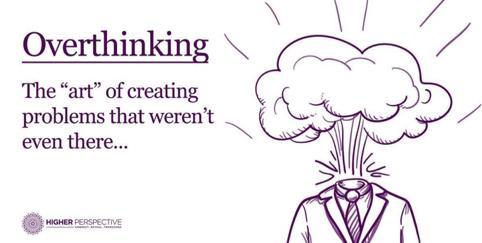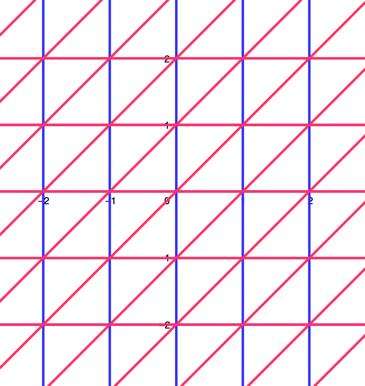
12 minute read
A Short Introduction to Linear Algebra
Social Media and Overthinking
One of the most famous sentences from René Descartes is “I think, therefore I am”. The ability to think is a gift that the creator gave to humankind. It is the single most important capability responsible for where the human race is with the development of its civilization.
We often hear: “Think before you act! Think through it!”
With the ability to think, can one overthink? We definitely can. We also often hear: “Don’t think too much about it”.
But what exactly is over-thinking if it does exist? At the risk of over-simplifying, overthinking can be defined as thinking way too far beyond the point of where reality actually stops. And no, this is not ignoring the question: what about imagination, which often happens beyond reality? Imagination is not the same as overthinking. It does not follow the same kind of logic. While thinking concerns what is possible within the domain of everyday life, imagination has its emphasis more on what is desirable, often without regard as to whether it is possible in the context of everyday life.
Overthinking has many variations. A scientist can do this by, for example, missing a critical clue that often takes a simpler and more mundane form than what they believe. A economist can overthink which subsequently leads to them over-complicating their model so that its ties to reality become tenuous. And so forth.
However, the main focus now is on overthinking in our daily lives.
Overthinking often occurs subconsciously and without us realising that we are doing it. It could be a simple phone conversation after which we worry that we may have said the wrong thing. As a result, we call another friend to ask for advice. This friend then repeats it to a third person, with their own colourings. The third person then to a fourth…then back to the person that they had the original conversation, resulting in a misunderstanding. This overthinking has thus mushroomed into a complex situation that cannot be easily resolved.
Take a job application: it is possible to overthink the cover letter: fifty drafts later and we might still worry that whoever receives and reads the cover letter may still potentially have questions that are not addressed the text. These so-called “what if” questions aggressively popping up in our minds every second. Eventually, our brain becomes so muddled that we can no longer think clearly, ending in a phenomenon known as “paralysis-byanalysis” trap.
Into the fray of these common daily overthinking situations comes social media. The biggest psychological effect of social media on many is the fear of missing out (FOMO). Seeing all those stories and images of other peoples’ glamorous lifestyles spin our minds into ways of overthinking that have never been seen before. We start to think of the many ways other people’s lives are superior to ours, worrying that we are missing out and that life is passing us by. The constant checking for messages even though there are none, or when there are only notifications from those who we aren’t wanting a response from as badly. When messages from friends don’t show up at the moment we refresh the page, we panic, thinking that they must have abandoned us and moved on to greener pastures. Furthermore, we imagine that at this very moment our friends must be at some big exciting gathering to which we have not been invited.
Being human has its perks, but it also has its drawbacks. One can argue that overthinking is one of these. At its worst, attenuated by social media, overthinking can bring ruin upon us. Overthinking can be like having the devil on our shoulder, with the ostensible purpose of protecting us but can instead lead to our downfall. One of the things it says is: “don’t let anyone else steal your thunder, only you are allowed to ruin your life!”. In certain cases this might be considered useful, however, once it sticks in our minds, we adhere to it and bring it around with us 16
everywhere we go. It takes control of us and thus ends up having ourselves destroying our own pleasantries first so that ‘others aren’t able to’.
So, what is the antidote?
It may not appear to be intuitively obvious, but at the most fundamental level, the resolution for overthinking is a healthy dose of confidence in oneself, this is because one of the big reasons for overthinking is our lack of self-confidence. We constantly have the urge to be reassured by others and this is one of the reasons we find ourselves asking for advice. Overthinking is often employed to address the self-doubt that is associated with a lack of confidence in oneself.
When we are self-confident, we tend to trust our own judgement and as a result, we are able to make decisions based on the judgement. When mistakes do occur, we deal with it not from fear for the mistakes’ possible consequences, but we think calmly about how to fix the situation if it requires a remedy. Again, take the example of the phone conversation in which we think we might’ve said something wrong: our self-confident selves would go straight back to the person we had spoken with to resolve the issues instead of going around to tell third or fourth parties. However, this does not mean we have to go straight into it and ask about whether we’ve said anything wrong - even though it could be one way of resolving the issue, if preferred. We can instead speak to them again and see how the situation is; if they are acting as they usually do. And if not? Then there is our chance to inquire about our suspected ‘hurtful’ actions.

Additionally, freeing ourselves from social media has often been proven to be tricky. It is an addiction, akin to smoking and drug use. Trying to short-circuit the overthinking part of the problem is a first step. Put the phone down: we have our own lives to get on with and constantly waiting for others is unnecessarily torturous as we cannot live their lives for them. So, naturally we do not know what they are doing or thinking at every second of every minute – it is a waste of time to try and guess anyway. Instead of our minds spinning constantly with the fear of missing out, focus on ourselves and what we have in front of us away from the device. The here and now. What is happening right now in my life? Have I got any exciting plans? If not, make some. It could be anything, with others or on our own.
It has to begin with trust and interest in oneself.
- Tatiana Y (L6)
17
A Short Intro to Linear Algebra
Before I begin, let me ask you a question: what is your favourite subject? Now, that may have been an easy question, or it may not have been. What is hard, is if I were to ask you: why? Now, quite often it could be simply because you are good at that subject. Maybe it was what your parents or friends were interested in. What I want to explore today, is that there is often more to a subject than you first think. That is what makes a subject interesting: when you break the surface of what the subject is really about and see how it fits together among all the other knowledge man has found.
I won’t be able to prove this for all the subjects, but I hope I can give you an insight into the world of maths beyond those monotonous calculations you learn. I hope to make you feel that it is instead a whole new language to describe the world around you in a concise yet beautiful manner. It is definitely not obvious to many that this is in fact the case.
Let us consider basic numbers for one moment. Quite straightforward, right? We use them all the time: 2 apples, 5 trees, 9 people, π houses. Well, maybe not all numbers are as useful as others in the real world. What is important to note, is how basic these numbers are. They can be described as one-dimensional. They manage perfectly well on their own to make some beautiful maths; most equations and formulae happen to use onedimensional numbers. But there is more: there are far more interesting numbers out there, waiting to be used. The kinds of ‘numbers’ I am going to be talking about today are called vectors.
It is very likely that you have come across a vector and that it is familiar to you. There are several ways which you can imagine a vector. Firstly, you can imagine it as a kind of list of numbers. For example: (3). This vector is 4 simply showing the list of numbers 3 and 4. You could also imagine a vector as an arrow in space. For example, this vector (3) would have ��-coordinate 4 3 and ��-coordinate 4. It would look like the diagram to the right:
Notice that this is now a kind of two-dimensional number. And with this kind of maths, which is called linear algebra, there is no limit to the number of dimensions you have. You can work with one hundred dimensions and the maths will still be the same. This is what makes this kind of maths both interesting and important.

18
Now you’re familiar with what a vector is and the kind of maths we are going to be working with, let’s get straight into looking at some linear algebra.
Let’s imagine we have our regular two-dimensional plane as shown to the left:
If we were to imagine that each of the points on this plane was a vector, then we could start to think about one of the most important parts of linear algebra: linear transformations. I want you to imagine that every point on the plane is going to move over to a different point (or a different vector to be precise). I will keep a copy of the original grid so that it is clear what has happened:
We can see that the lines have been tilted space one unit to the right.
Instead of focusing on the whole grid, try focusing on just two vectors. These vectors are (1) ������ (0). We call them �� and ��0 1 respectively. These are called our unit vectors since �� goes one unit along the ��-axis and �� goes one unit up the ��-axis. This is not obvious from what is shown, but I can tell you that �� has moved to the vector (0) (in other words, it hasn’t shifted) and �� moved to the 1 vector (1) (in other words, one unit along the ��-axis). The rest of 1 the vectors on the plane moved according to this. For example, the vector (2 2) moved to the vector (4 2
) and the vector (3) stayed in place. Notice that all the lines remained parallel and evenly spaced, and the origin stayed in 0 place. This is what a linear transformation is. What is useful about linear transformations is that all we need to know is where �� and �� have landed, and we can work out where any vector has landed.

Using that same linear transformation, let’s try to predict where a certain vector lands. Let’s say we pick the vector (5). If we know that �� has stayed in place and �� moved to (1), we might think about a very basic piece of 4 1 information: �� is just a unit in the �� direction and �� is just a unit in the �� direction. Therefore, any vector could be expressed as a multiple of �� and �� added together. For example, we might write the vector (1) as 1��+2��= 2 1(1)+2(0)=(1)+(0)=(1). I might not have taught you how to add and multiply vectors, but doesn’t it 0 1 0 2 2 just feel right to do it like this? If not, then have a look at the following formulae and make sure it makes sense to you before you move on:
We call this kind of representation of a vector a linear combination. This is simply when you multiply two vectors by two numbers and add them together. Here is some maths vocab for you, just to make everything a bit more formal:
Multiplying = scaling (because it stretches or compresses a vector) Normal number = scalar (because it scales a vector) Adding and scaling vectors = linear combination
Because �� is simply a unit along the ��-axis, multiplying this with a number will give you a vector with only an ��coordinate. Let me run through an example so that it is clear:
(1 0)∙4=(4 0) (just the ��-coordinate)
The same applies for �� when you multiply it by a number: you will just get a vector with a ��-coordinate. This means that when you add them together, you will get a vector with the ��-coordinate of the first number and ��coordinate of the second number. For example:
19
(1 0)∙4+ (0 1)∙2= (4 2)
This is a linear combination. In fact, any vector can be expressed with the following linear combination:
This is important for what we are about to do, so make sure this makes sense to you.
When thinking about a linear transformation, we record where �� and �� have landed in a matrix which is like a 2x2 vector. For our example earlier, it would look like this:
(1 1 0 1)
Where the first column is where �� landed and the second column is where �� landed. Using our idea that any vector can be expressed as a linear combination of �� and �� we might try the following:
And indeed, this is true. This is extremely useful, because now we can work out where any vector we want has landed. For example:
(1 0)∙5+(1 1)∙4=(9 4)
And this is where the vector (5) would have gone to after the transformation. This is a really key part of linear 4 algebra, and I find it quite an elegant way to visualise it, don’t you?
Before we finish, I want you to feel as though you’ve gained a thorough understanding of what you’ve learned. It is important to realise that, although it is straightforward, it is not obvious what is going on. The idea of linear transformations is fundamental to your understanding of linear algebra, and it is important that we dig even deeper into the concept.
So far, we’ve learned that to find out where a vector has landed after a linear transformation we need to record where �� and �� have landed after the transformation. Using linear combinations, we can then see where our vector has moved to. It is quite a straightforward process when broken down like this.
Let’s now imagine that instead of just one transformation, you want to know what would happen after two consecutive linear transformations. Let’s say you want to know the overall effect of both of these linear transformations. Let me show an example to the right so that you can visualise it:








